| Columns Retired Columns & Blogs |
T&F Sun (Stereophile Class-A, limited LF) may be a better value for the money, at about less than half the price of Osiris :-) ..........
I used DRA Labs' MLSSA system and a calibrated DPA 4006 microphone to measure the Trenner & Friedl Osiris's frequency response in the farfield, and an Earthworks QTC-40 mike for the nearfield responses. As the speaker's front baffle is angled back by approximately 10°, I wasn't sure at first what would be the optimal axis on which to measure the Osiris's farfield behavior. I usually place the microphone level with the tweeter. However, with the speaker supported by its rectangular feet, the center of the Osiris's coaxial drive-unit is just 27" from the floor, which is 9" below the height of an average seated listener's ears. For the farfield measurements, therefore, I placed the microphone perpendicular to the baffle on the tweeter axis, which will be the listening axis for a seated listener at least 5' away. As you will see later, this didn't significantly affect the measurements. I didn't remove the loudspeaker's grille.
Trenner & Friedl specifies the Osiris's sensitivity as 88.7dB/2.83V/m, which is higher than average. My estimate was slightly lower than the specification, at 87.7dB/2.83V/m. The specified impedance is 8 ohms. While the impedance magnitude (fig.1, solid trace) briefly drops below 8 ohms in the lower midrange, with a broader drop to 6 ohms in the treble, the impedance is greater than 8 ohms over much of the audioband. The 8 ohm specification is appropriate, therefore. Though the electrical phase angle (dotted trace) is extreme at some bass frequencies, the magnitude is high at those frequencies, mitigating the loudspeaker's demand for current. The Osiris is a relatively easy load for amplifiers to drive.
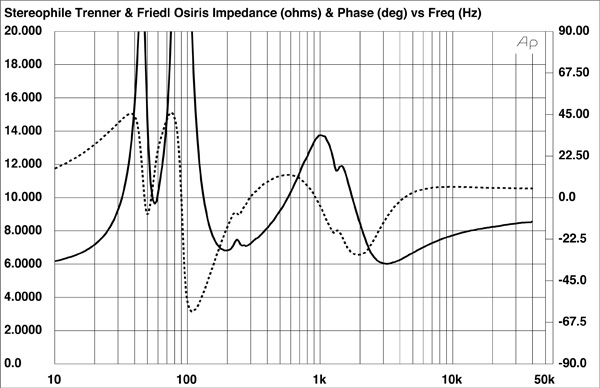
There are significant discontinuities between 200Hz and 300Hz and between 1kHz and 2kHz in the impedance traces. These imply that there are resonances of some kind in these two regions. I used a plastic-tape accelerometer to investigate the enclosure's vibrational behavior, and I found modes at 227Hz and 1.4kHz on all the enclosure's surfaces (fig.2). However, these modes are relatively low in level and of high Q, meaning that it takes a relatively long time for them to be fully excited.
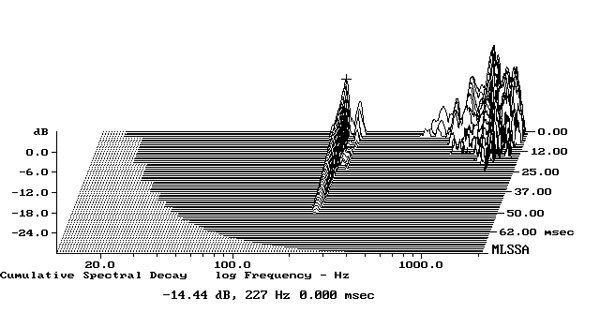
The impedance magnitude trace has a saddle centered on 57Hz, which suggests that this is the tuning frequency of the vent formed by the open end of the cabinet's base when the Osiris stands on its twin rectangular feet. However, the woofer's nearfield response (fig.3, blue trace) has its minimum-motion notch a little lower in frequency, at 53Hz, and the output from the cabinet's open base (red trace) peaks at 53Hz. The complex sum of the woofer and base-vent outputs (black trace) rolls off rapidly below 50Hz, and perhaps more significantly, the usual rise in the upper bass that would be due to the nearfield measurement technique is absent. The Trenner & Friedl doesn't appear to offer greater quasi-anechoic low-frequency extension than the PSB Alpha P5 minimonitor I reviewed in October, though the fact that the Osiris's vent is close to the floor will boost its output.
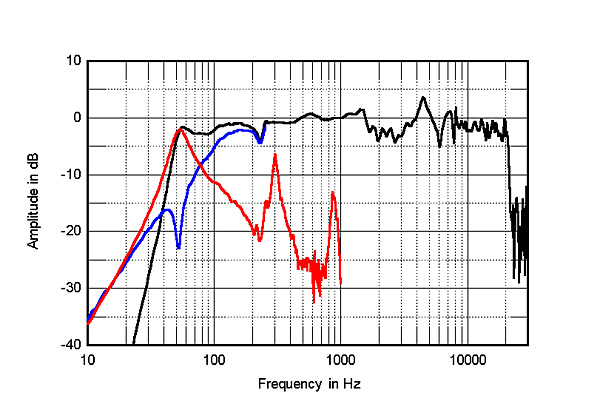
The nearfield output of the 6.5" woofer has a suckout present centered close to 227Hz, the frequency of one of the panel resonances I showed in fig.2, which suggests that there is some sort of antiresonance present. However, while the nearfield output of the vent doesn't have any suckout or resonance present at that frequency, its upper-frequency rollout is disturbed by two high-level peaks at 300Hz and 860Hz. As the speaker's open base faces the floor, this behavior might look worse than it sounds, but it is not something I like to see.
Higher in frequency in fig.3, a relatively even farfield response, averaged across a 30° horizontal window centered on the tweeter axis, is disturbed by small peaks at 1.4kHz and 4.5kHz—the former is the frequency of the second of the panel resonances I mentioned earlier—and a lack of presence-region energy. The tweeter's output rolls off rapidly above 20kHz.
The Trenner & Friedl Osiris's horizontal dispersion, with each trace normalized to the tweeter-axis response, is shown in fig.4. The contour lines in this graph are not particularly even, but by comparing this graph with fig.3, it can be seen that the peak at 1.4kHz and the lack of energy immediately above the peak in the on-axis output tend to be compensated for to the speaker's sides. Experimenting with toe-in should give a relatively even midrange and low-treble balance. In the vertical plane (fig.5), the Trenner & Friedl's tweeter-axis balance on an axis perpendicular to the sloped-back baffle is preserved over a ±15° window.

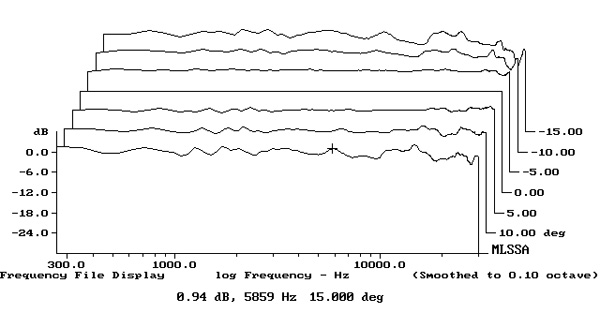
In the time domain, the Osiris's step response on the tweeter axis (fig.6) is complex. It appears that while the woofer is connected in positive acoustic polarity, the coaxially mounted tweeter is connected in inverted polarity. The tweeter's output arrives at the microphone around 250µs after that of the woofer. The Trenner & Friedl's cumulative spectral-decay plot (fig.7) is also complex. There are some low-level ridges of delayed energy in the region above the on-axis response peak at 1.4kHz, as well as other resonances in the mid and high treble.
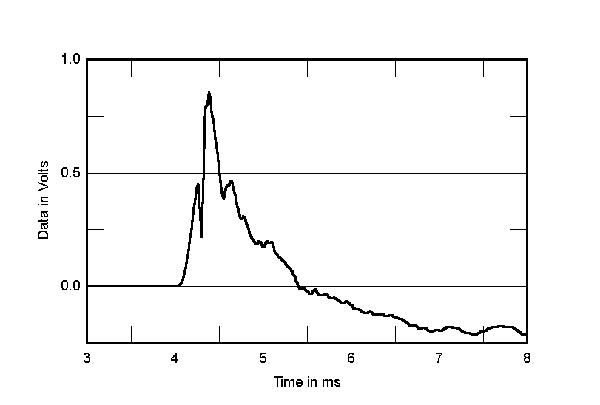
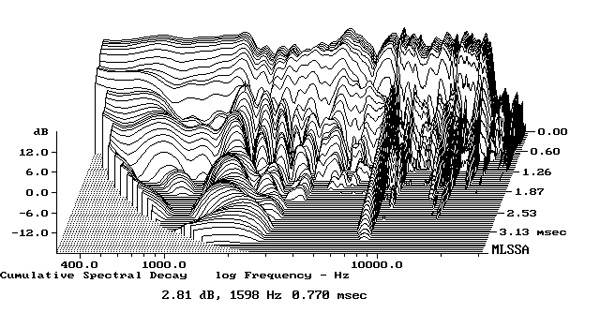
I was intrigued by the Trenner & Friedl Osiris's design: a domestically friendly enclosure featuring a coaxial drive-unit with the woofer's rear wave loaded by an internal horn, the latter venting in a manner that gives reflex action. Even so, I feel that this loudspeaker's measured performance suggests that the unusual design approach has introduced problems that have not been fully resolved.—John Atkinson

T&F Sun (Stereophile Class-A, limited LF) may be a better value for the money, at about less than half the price of Osiris :-) ..........

... Klipsch La Scala II speakers. It's been over a decade since "Sam Tellig" sampled them. Perhaps KM can review current production units, or maybe the somewhat pricier latest AL5 iteration. His 20-30W tube amps should be a good match for them.

The Golden Ear Reference is in this range, as well.
It's a fascinating market point. This price is where speakers really seem to break loose of the main cost constraints and really start the party!
The T & F speakers are sure pretty, though!

I live in Austin (Round Rock is a suburb, and I recognized the road on which they're located so I googled it), and that address is a freakin' PostalAnnex+. They're not even a real company, just a box at a retail shipping service. They literally don't exist as a physical entity and their phone number (510 area code) is based in the Bay Area of California. Diety of your choice help you if you need US service for anything they distribute (like 5 obscure brands)....

Profundo will celebrate it's 20th anniversary next year. We moved to the Austin area 8 years ago from the SF Bay Area. Due to frequent travel and for continuity's sake, we have maintained our original phone number, which is mobile. Owing to the high value of the equipment we import and stock, we, like many distributors, maintain a mailing address that is separate from our physical location. We are not open to the public, as we sell through a dealer network.
I have to question the motivation for such a comment, other than just trolling. It does not address the product reviewed, its performance, or anything else relevant to the enjoyment of music, which is our primary goal in this industry. We support all our products, which rarely require service. The "youngest" product for us has been in our lineup since 2003, so these are not fly-by-night companies, rather, they are small, high-quality manufacturers that have very solid reputations worldwide, both for sound quality and reliability.
Since the author, "supamark" is a neighbor, perhaps he would like to meet for coffee sometime and learn more about our company and, also, maybe something about the products we import. We, and they, are quite real.

In my experience such a resonance as seen at 227 Hz is most often caused by an internal standing wave. Using 343/227/2 the internal dimension should be 0.76 m, which might very well match the internal height. It can be confirmed by measurements or by adding additional absorption in the bottom.

Aloha from Hawaii Audio! Just read this review and comments, and was saddened to see the comments about Profundo.
Bob Clarke is a CLASS ACT; I have communicated with him since at least 2005, when I was importing S.A.P. Audio of Salerno & exhibiting at CES. Always a big fan of VIVA Audio and also Transfiguration.
I bothered Bob on numerous occasions with inquiries; he was ALWAYS super responsive, courteous and professional.
Amazed and humbled that he is still running an audio import business in 2019. Hats off to him...and let's SUPPORT those who are still at it, instead of trying to tear them down...
Mahalo from Hawaii, for all your good will and professionalism all these many years, Bob!
Terry Hart
Hawaii Audio / S.A.P. Audio Int'l